外研版小学英语单词和语法复习
(完整word版)外研版小学英语语法总复习知识点归纳
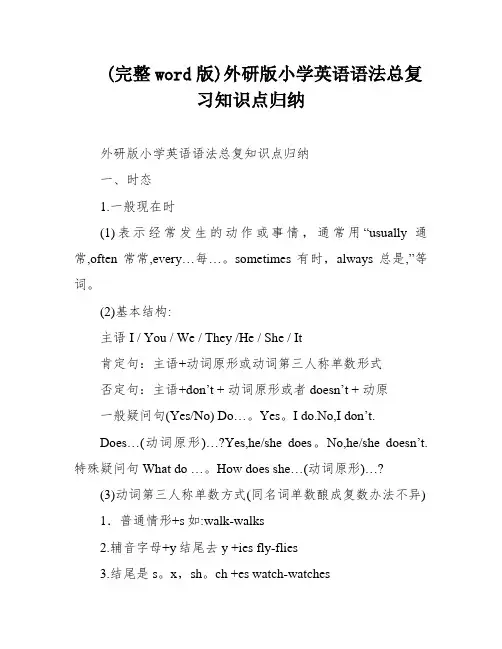
(完整word版)外研版小学英语语法总复习知识点归纳外研版小学英语语法总复知识点归纳一、时态1.一般现在时(1)表示经常发生的动作或事情,通常用“usually通常,often常常,every…每…。
sometimes有时,always总是,”等词。
(2)基本结构:主语I / You / We / They /He / She / It肯定句:主语+动词原形或动词第三人称单数形式否定句:主语+don’t + 动词原形或者doesn’t + 动原一般疑问句(Yes/No) Do…。
Yes。
I do.No,I don’t.Does…(动词原形)…?Yes,he/she does。
No,he/she doesn’t.特殊疑问句What do …。
How does she…(动词原形)…?(3)动词第三人称单数方式(同名词单数酿成复数办法不异)1.普通情形+s如:walk-walks2.辅音字母+y结尾去y +ies fly-flies3.结尾是s。
x,sh。
ch +es watch-watches4.结尾是0 +es do-does。
go-goes5.特殊have-has2.现在进行时(1)表示正在发生的动作,通常用“now现在。
look看,XXX听”.(2)根本方式: be +动词-ingeg: I am(not) XXX.You/We/They are(not) reading。
He/She/It is(not) eating.What are you doing。
Is he reading?(3)动词的目前分词方式(动词+ing)普通情形+ing walk—walking末端是不发音的e-e+ingcome—coming重读闭音节双写末了一个字母+ingswim-swimming。
run-running3.一般过去时(1)表示过去已经发生的事情,通常用“last …上一个…。
just now刚才,many years ago许多年前,XXX昨天”等词。
(word完整版)小学三至六年级英语语法及重点词汇(外研版)
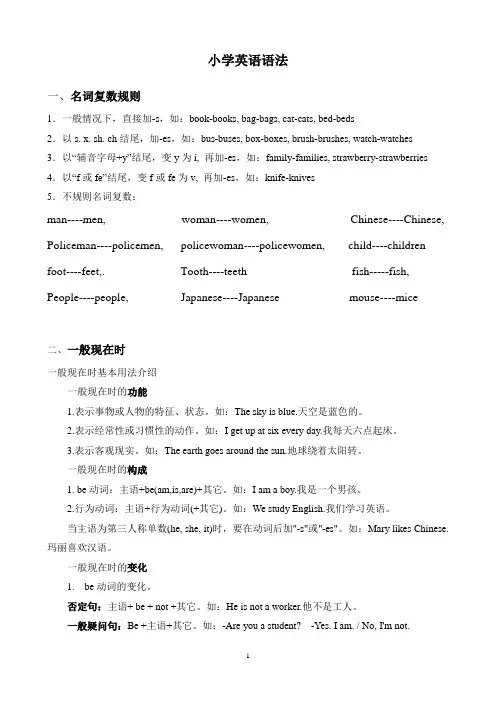
小学英语语法一、名词复数规则1.一般情况下,直接加-s,如:book-books, bag-bags, cat-cats, bed-beds2.以s. x. sh. ch结尾,加-es,如:bus-buses, box-boxes, brush-brushes, watch-watches3.以“辅音字母+y”结尾,变y为i, 再加-es,如:family-families, strawberry-strawberries 4.以“f或fe”结尾,变f或fe为v, 再加-es,如:knife-knives5.不规则名词复数:man----men, woman----women, Chinese----Chinese, Policeman----policemen, policewoman----policewomen, child----children foot----feet,. Tooth----teeth fish-----fish, People----people, Japanese----Japanese mouse----mice二、一般现在时一般现在时基本用法介绍一般现在时的功能1.表示事物或人物的特征、状态。
如:The sky is blue.天空是蓝色的。
2.表示经常性或习惯性的动作。
如:I get up at six every day.我每天六点起床。
3.表示客观现实。
如:The earth goes around the sun.地球绕着太阳转。
一般现在时的构成1. be动词:主语+be(am,is,are)+其它。
如:I am a boy.我是一个男孩。
2.行为动词:主语+行为动词(+其它)。
如:We study English.我们学习英语。
当主语为第三人称单数(he, she, it)时,要在动词后加"-s"或"-es"。
小学英语四年级下册课本知识点(外研版三年级起点)
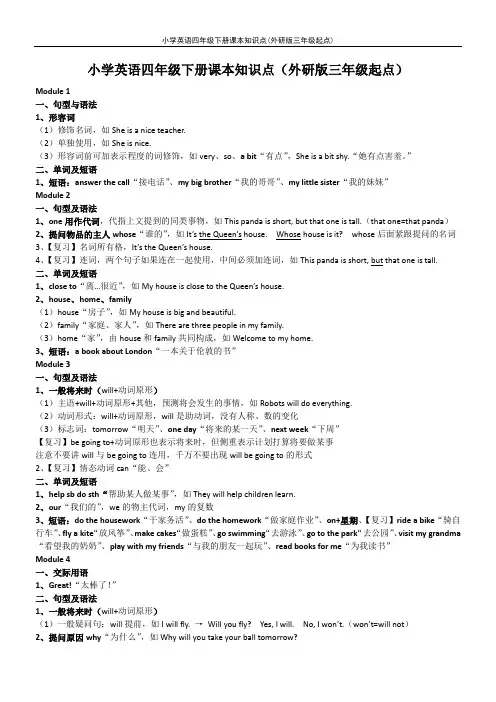
小学英语四年级下册课本知识点(外研版三年级起点)Module 1一、句型与语法1、形容词(1)修饰名词,如She is a nice teacher.(2)单独使用,如She is nice.(3)形容词前可加表示程度的词修饰,如very、so、a bit“有点”,She is a bit shy.“她有点害羞。
”二、单词及短语1、短语:answer the call“接电话”、my big brother“我的哥哥”、my little sister“我的妹妹”Module 2一、句型及语法1、one用作代词,代指上文提到的同类事物,如This panda is short, but that one is tall.(that one=that panda)2、提问物品的主人whose“谁的”,如It’s the Queen’s house. Whose house is it? whose后面紧跟提问的名词3、【复习】名词所有格,It’s the Queen’s house.4、【复习】连词,两个句子如果连在一起使用,中间必须加连词,如This panda is short, but that one is tall.二、单词及短语1、close to“离…很近”,如My house is close to the Queen’s house.2、house、home、family(1)house“房子”,如My house is big and beautiful.(2)family“家庭、家人”,如There are three people in my family.(3)home“家”,由house和family共同构成,如Welcome to my home.3、短语:a book about London“一本关于伦敦的书”Module 3一、句型及语法1、一般将来时(will+动词原形)(1)主语+will+动词原形+其他,预测将会发生的事情,如Robots will do everything.(2)动词形式:will+动词原形,will是助动词,没有人称、数的变化(3)标志词:tomorrow“明天”、one day“将来的某一天”、next week“下周”【复习】be going to+动词原形也表示将来时,但侧重表示计划打算将要做某事注意不要讲will与be going to连用,千万不要出现will be going to的形式2、【复习】情态动词can“能、会”二、单词及短语1、help sb do sth“帮助某人做某事”,如They will help children learn.2、our“我们的”,we的物主代词,my的复数3、短语:do the housework“干家务活”、do the homework“做家庭作业”、on+星期、【复习】ride a bike“骑自行车”、fly a kite“放风筝”、make cakes“做蛋糕”、go swimming“去游泳”、go to the park“去公园”、visit my grandma “看望我的奶奶”、play with my friends“与我的朋友一起玩”、read books for me“为我读书”Module 4一、交际用语1、Great!“太棒了!”二、句型及语法1、一般将来时(will+动词原形)(1)一般疑问句:will提前,如I will fly. →Will you fly? Yes, I will. No, I won’t.(won’t=will not)2、提问原因why“为什么”,如Why will you take your ball tomorrow?(1)回答:Because we are going to have a picnic tomorrow.(2)Why not?“为什么不呢”,Why won’t you do sth?=Why not do sth?eg:Why won’t you take your ball tomorrow? = Why not take your ball tomorrow?3、连词because“因为”、so“所以”,注意英语中because和so不能连用eg:Because we are going to have a picnic tomorrow, I will take my kite.We are going to have a picnic tomorrow, so I will take my kite.【复习】so“如此、这么”,如It is so hot today.4、询问天气What will be the weather?“天气怎么样?”,回答It will be+形容词,如It will be sunny.注意:will后要求加动词原形,am/is/are的原形是be,如It is sunny today. →It will be sunny tomorrow.三、单词及短语1、take“带着、拿着”,如take your kite“带着你的风筝”【复习】take“拍摄”,如take pictures“拍照”2、名词变形容词:sun-sunny、cloud-cloudy、wind-windy3、短语:have a picnic“去野餐”、【复习】in+地点,如in HaikouModule 5一、句型及语法1be动词)(1)主语+be动词过去式+其他,表示过去的情况,如I was two then.“我那时两岁”←I am ten now.“我现在十岁。
(完整版)外研版小学英语六年级上册语法知识点总结
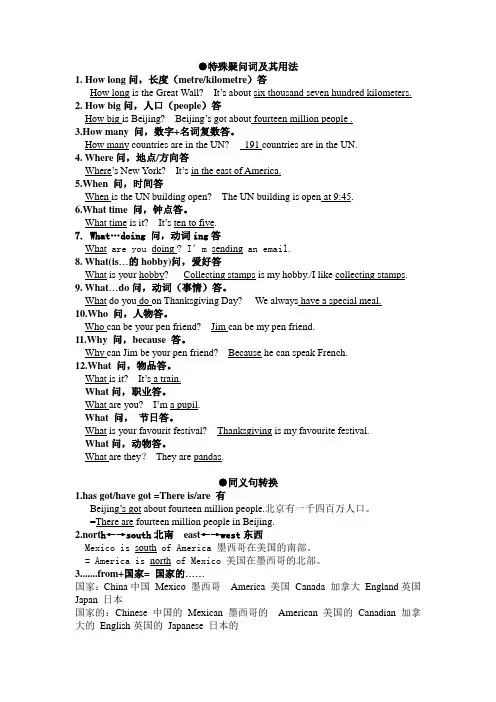
●特殊疑问词及其用法1. How long 问,长度(metre/kilometre)答How long is the Great Wall? It’s about six thousand seven hundred kilometers.2. How big 问,人口(people)答How big is Beijing? Beijing’s got about fourteen million people .3.How many 问,数字+名词复数答。
How many countries are in the UN? 191 countries are in the UN.4. Where问,地点/方向答Where’s New York? It’s in the east of America.5.When 问,时间答When is the UN building open? The UN building is open at 9:45.6.What time 问,钟点答。
What time is it? It’s ten to five.7. What…doing 问,动词ing答What are you doing ? I’m sending an email.8. What(is…的hobby)问,爱好答What is your hobby? Collecting stamps is my hobby./I like collecting stamps. 9. What…do问,动词(事情)答。
What do you do on Thanksgiving Day? We always have a special meal.10.Who 问,人物答。
Who can be your pen friend? Jim can be my pen friend.11.Why 问,because 答。
(完整版)外研版小学英语六年级上册语法知识点总结
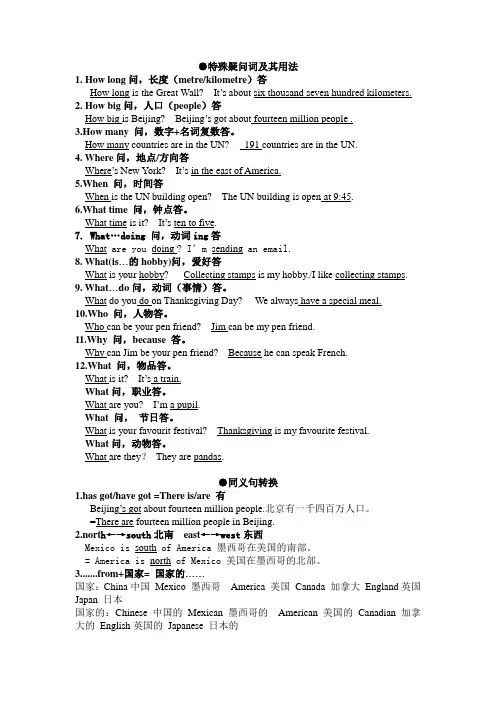
●特殊疑问词及其用法1. How long 问,长度(metre/kilometre)答How long is the Great Wall? It’s about six thousand seven hundred kilometers.2. How big 问,人口(people)答How big is Beijing? Beijing’s got about fourteen million people .3.How many 问,数字+名词复数答。
How many countries are in the UN? 191 countries are in the UN.4. Where问,地点/方向答Where’s New York? It’s in the east of America.5.When 问,时间答When is the UN building open? The UN building is open at 9:45.6.What time 问,钟点答。
What time is it? It’s ten to five.7. What…doing 问,动词ing答What are you doing ? I’m sending an email.8. What(is…的hobby)问,爱好答What is your hobby? Collecting stamps is my hobby./I like collecting stamps. 9. What…do问,动词(事情)答。
What do you do on Thanksgiving Day? We always have a special meal.10.Who 问,人物答。
Who can be your pen friend? Jim can be my pen friend.11.Why 问,because 答。
小学英语新外研版(一起)四年级上册M3知识点
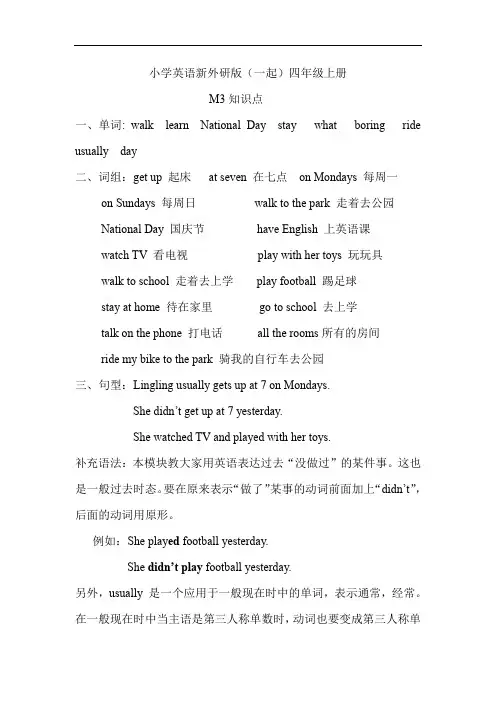
小学英语新外研版(一起)四年级上册M3知识点一、单词: walk learn National Day stay what boring ride usually day二、词组:get up 起床at seven 在七点on Mondays 每周一on Sundays 每周日walk to the park 走着去公园National Day 国庆节have English 上英语课watch TV 看电视play with her toys 玩玩具walk to school 走着去上学play football 踢足球stay at home 待在家里go to school 去上学talk on the phone 打电话all the rooms所有的房间ride my bike to the park 骑我的自行车去公园三、句型:Lingling usually gets up at 7 on Mondays.She didn’t get up at 7 yesterday.She watched TV and played with her toys.补充语法:本模块教大家用英语表达过去“没做过”的某件事。
这也是一般过去时态。
要在原来表示“做了”某事的动词前面加上“didn’t”,后面的动词用原形。
例如:She play ed football yesterday.She didn’t play football yesterday.另外,usually 是一个应用于一般现在时中的单词,表示通常,经常。
在一般现在时中当主语是第三人称单数时,动词也要变成第三人称单数。
如:She usually gets up at 6 in the morning.。
(一年级起点)新版外研社小学英语五年级下册M1-M10知识点汇总
外研版(一起)第十册英语复习要点整理Module 1词汇:1、drive(过去式drove)驾驶2、flute笛子3、player演奏者4、office办公室5、factory(复数)factories6、shop商店7、hospital医院8、fish 捕鱼,钓鱼(动词)9、farm农场职业名称拓展:1、farmer农民2、postman邮递员3、doctor医生4、nurse护士5、firefighter / fireman消防员6、writer作家7、driver司机8、policeman警察短语:1、in the picture在照片上2、drive a bus驾驶公共汽车3、Chinese music中式音乐4、play the flute吹笛子5、teach English教英语6、work in an office在办公室工作7、work in a factory在工厂工作8、work in a shop在商店工作9、work in a hospital在医院工作10. work on a farm 在农场工作11. a flute / an erhu player 一位笛子(二胡)演奏者12、work at a school 在学校工作13、work at a bank在银行工作语法要点:本模块我们主要学习用一般现在时形式和一般过去时形式谈论某人的职业和具体工作。
要关注时间状语before/now,区分时态。
询问职业及职业中的细分类时要用特殊疑问词What .例:What did your father do ?What does your father do ?询问工作场所要用特殊疑问词Where例句:Where did your father work?Where does your father work ?主要句型:She was a driver before. 以前她是个司机。
外研版小学英语六年级上册语法知识点总结
●特殊疑问词及其用法1. How long 问,长度(metre/kilometre)答How long is the Great Wall It’s morn than twenty thousand kilometers long.2. How big 问,人口(people)答How big is Beijing Beijing has got about twenty million people .many 问,数字+名词复数答。
How many countries are in the UN 193 countries are in the UN.4. Where问,地点/方向答Where’s New York It’s in the east of America.问,时间答When did you come back I came back last Sunday.time 问,钟点答。
What time is it It’s ten to five.7. What…doing 问,动词ing答What are you doing I’m sending an email.8. What(is…的hobby)问,爱好答What is your hobby Collecting stamps is my hobby./I like collecting stamps.9. What…do问,动词(事情)答。
What do you do on Thanksgiving Day We always have a special meal.问,人物答。
Who can be your pen friend Jim can be my pen friend.问,because 答。
Why can Jim be your pen friend Because he can speak French.问,物品答。
外研版小学英语(一年级起点)四年级上册四会词及重点句型
四年级上册四会词及重点句型Module 11、重点单词:well好,live居住,tell告诉,warm温暖的,China中国, Chinese中国人2、重点短语:a photo of...的照片,in red 穿红色衣服的,a bit cold有点冷,read a letter 读信,tell me about...讲讲关于...,3、重点语法:①现在进行时,表示正在做某事What are you doing? I am…Be动词(am\is\are)+动词ing 表示在干什么②一般过去时be动词变为was\were 单数用was, 复数用were4、重点句型:It was my birthday on+具体某天(如Saturday)我的生日在...We were at+地点(如the Great Wall)我们在...I’ve(=I have) got a new friend.我有一个新朋友。
He’s(=He has) got short,yellow hair.他有短的、黄色的头发。
Write to me soon. 快给我回信吧。
Thank you for your letter. 多谢你的来信I will be eleven next year. 将来时will be表示将要怎样,Module 21、重点单词:wash-washed 洗,clean-cleaned打扫, finish-finished完成,help-helped帮助cook-cooked 煮,phone-phoned打电话,watch-watched看,paint-painted 绘画shirt衬衣,skirt裙子,trousers 裤子,dirty脏的,2、重点短语:cook noodles煮面条,watch TV看电视,paint a picture 画画,play the flute 吹笛子,listen to music听音乐3、重点语法:一般过去时,表示过去做了某事,变化方式:常规变化v+ed4、重点句型:重点句型:I/He/She +动词过去式...(如I helped my mum.)Module 31、重点单词:talk-talked交谈,homework家庭作业,National Day国庆节,toy玩具(复数+s)on Monday s每周一(每个周一复数),2、重点短语:get up起床,walk to school, play with和...玩耍, ride my bike骑自行车,have English in school 在学校上英语课,play football踢足球,in the park在公园,stay at home待在家,all the rooms全部的房间,talk on the phone 在电话里交谈,3、重点语法:①一般现在时,表示常常习惯做某事,标志词语:every day\usually\often\always\on Mondays(每一个周日),注意第三人称单数要+s\es.I usually+动词原形(如I usually get up at 7’clock.)我通常...He/She+动词s/es....(如She usually gets up at 7’clock.)他、她通常...②一般过去时,didn’t+动词原形,表示过去没有做某事I/He/She didn’t +动词原形....yesterday.(如I didn’t get up at 7’clock yesterday.)我/他/她没有....4、重点句型:I usually ride my bike to the park.But I didn’t ride my bike yesterday.It was raining.昨天下雨了,What a boring day!Module 41、重点单词:paper纸,printing印刷术,print-printed打印,between在...之间,beside在...旁边,单数man-复数men男人,单数woman-复数women 女人,right正确的,clever 聪明的,important 重要的,invent-invented发明,newspapers 报纸,chair 椅子,单数mouse-复数mice 老鼠,bicycle自行车,listen-listened 听2、重点短语:in front of(在...前面),between A and B (在A和B之间)between sth (在两个相同的东西之间)Between the two cars 两辆车之间beside sth (在XX旁边)3、重点语法:准确表示方位巩固过去时的用法4、重点句型:Chinese people invented paper/printing.中国人发明了造纸术/印刷术。
小学三至六年级英语语法及重点词汇(外研版)
小学英语语法一、名词复数规则1.一般情况下,直接加-s,如:book-books, bag-bags, cat-cats, bed-beds2.以s. x. sh. ch结尾,加-es,如:bus-buses, box-boxes, brush-brushes, watch-watches3.以“辅音字母+y”结尾,变y为i, 再加-es,如:family-families, strawberry-strawberries 4.以“f或fe”结尾,变f或fe为v, 再加-es,如:knife-knives5.不规则名词复数:man----men, woman----women, Chinese----Chinese, Policeman----policemen, policewoman----policewomen, child----children foot----feet,. Tooth----teeth fish-----fish, People----people, Japanese----Japanese mouse----mice二、一般现在时一般现在时基本用法介绍一般现在时的功能1.表示事物或人物的特征、状态。
如:The sky is blue.天空是蓝色的。
2.表示经常性或习惯性的动作。
如:I get up at six every day.我每天六点起床。
3.表示客观现实。
如:The earth goes around the sun.地球绕着太阳转。
一般现在时的构成1. be动词:主语+be(am,is,are)+其它。
如:I am a boy.我是一个男孩。
2.行为动词:主语+行为动词(+其它)。
如:We study English.我们学习英语。
当主语为第三人称单数(he, she, it)时,要在动词后加"-s"或"-es"。
- 1、下载文档前请自行甄别文档内容的完整性,平台不提供额外的编辑、内容补充、找答案等附加服务。
- 2、"仅部分预览"的文档,不可在线预览部分如存在完整性等问题,可反馈申请退款(可完整预览的文档不适用该条件!)。
- 3、如文档侵犯您的权益,请联系客服反馈,我们会尽快为您处理(人工客服工作时间:9:00-18:30)。
有暴风雨的
晴天
['reini]
['stɔ:mi]
['sʌni]
35
十、认识天气、冷热
多云
多雪
有风
['klaudi]
[snəui]
['windi]
36
十、认识天气、冷热
冷
暖和
热
[kəuld]
[wɔ:m]
[hɔt]
37
一般现在时
表示包括“现在”在内的一段时间内经常发生的动作或存
在的状态,常与often, usually, every day, always,
蛋糕
面包
[keik]
[bred]
23
七、认识食物、食品
奶酪
巧克力
鸡蛋
[tʃi:z]
['tʃɔkəlit]
[eg]
24
七、认识食物、食品
汤
米饭
冰淇淋
[su:p]
[rais]
[ais'kri:m]
25
八、认识动物
小鸡
鸟
一只猫
['tʃikin]
[bə:d]
[kæ t]
26
八、认识动物
鸭子
狗
大象
[dʌk]
女巫/ 巫婆 驾驶员
男孩
[witʃ]
[draivə]
5
二、认识人物、职业
裁缝
[teilə]
圣诞老人
['sæntə]
百合花
['lili]
6
二、认识人物、职业
医生
农民
爸爸
[dɔktə]
['fɑ:mə ]
['fɑ:ðə]
7
二、认识人物、职;niə]
['fæ mili]
一、认识水果
桔子
葡萄
桃子
['ɔ:rindʒ]
1
一、认识水果
西红柿
草莓
梨
[tə'mɑ:təu, -'mei]
['strɔ:bəri]
[pɛə] 2
一、认识水果
菠萝
樱桃
['pain,æ pl]
['hɔli]
3
二、认识人物、职业
安迪
天使
男孩
['æ ndi]
['eindʒəl]
[bɔi] 4
二、认识人物、职业
[hæ t]
31
九、认识衣物
衬衫/衬衣
凉鞋
围巾
[ʃə:t]
[sæ ndlz]
[skɑ:f]
32
九、认识衣物
裙子
鞋子
短裤
[skə:t]
[ʃu:z]
[ʃɔ:ts]
33
九、认识衣物
毛衣
短袜
长袜
Sweater [‘swetə]
[sɔks]
[‘stɔki
ŋ]
34
十、认识天气、冷热
下雨的/多雨的/阴雨 的
[ɡə:l ]
8
三、认识人体器官
手臂
脚
耳朵
[ɑ:m]
[fut]
[iə]
9
三、认识人体器官
眼
眼睛
脸
[ai]
[aiz]
[feis]
10
三、认识人体器官
手
头
膝盖
[hæ nd]
[hed]
[ni:]
11
三、认识人体器官
腿
嘴
脖子
[leg]
[mauθ]
[nek]
12
三、认识人体器官
鼻子
肩膀
手指
[nəuz]
[dɔg]
['elifənt]
27
八、认识动物
鱼
猴子
熊猫
[fiʃ]
['mʌŋki]
['pændə]
28
八、认识动物
老虎
兔子
猫
[ 'taigə ]
['ræ bit]
[kæ t]
29
九、认识衣物
连衣裙
鞋子
[dres]
[bu:ts]
[kæ p]
30
九、认识衣物 牛仔裤
夹克衫
帽子
[dʒi:nz]
['dʒækit]
棕色的
蓝色的
[blæ k]
[braun ]
[blu:]
19
五、认识颜色
黄色的
白色的 粉色的
['jeləu]
[hwait]
[piŋk]
20
六、认识日常用品
盒子
电扇
餐叉
[bɔks]
[fæ n]
[fɔ:k]
21
六、认识日常用品
拳击手套
眼镜
勺子
[glʌvz]
['glɑ:siz]
[spu:n]
22
七、认识食物、食品
3. We like _p_la__y_in__g_ (play) basketball after class.
4. I like singing. I often _l_is_t_e_n__ (listen) to music in
the evening.
5. My grandma w__a_t_c_h_e_s_ (watch) TV every day.
goes等
③ 以辅音字母加y结尾的动词,先变y为i,再加es,如
studies, flies
have的第三人称单数形式为has。
38
一、用单词的适当形式填空。
1. Mike _d_o__e_s___ (do) his homework everyday.
2. There _i_s______ (be) some water in the glass.
sometimes等词连用。
如:I often go to school on foot. Mike watches TV
every day.
☆注意☆ 英语动词的现在时与原形同形,但当主语是第
三人称单数时,
动词形式需做以下变化:
① 一般在动词末尾加s,如likes, plays等
② 以字母s, x, ch, sh, o结尾的动词加es,如watches,
动词第三人称单数
1. work _w__o_r_k_s__ 2. learn _le_a_r_n__s__ 3. go _g_o_e__s___
4. teach _t_e_a_c_h_e__s 5. watchw__a_tc_h__e_s6. have _h_a__s___
7. study _s_t_u_d__ie_s_ 8. fly _f_li_e_s____
橡皮
['pensəl]
[pensəl 'keis]
[i'reizə ]
16
四、认识学习用品及工具
铅笔盒
铅笔刀/转笔刀
尺子
[pensəl 'keis] [pensəl 'ʃɑ:pənə]
['ru:lə]
17
五、认识颜色
红色的
绿色的
蓝色的
[red]
[gri:n]
['pə:pl]
18
五、认识颜色
黑色的
shoulders
['ʃəuldəz]
['fiŋɡə]
13
四、认识学习用品及工具
背包
书包
书
['bæ kpæ k]
[bæ g]
[buk]
14
四、认识学习用品及工具
英语书
计算器
床头柜
['iŋɡliʃ 'buk] ['kælkjuleitə]
[end 'teibl]
15
四、认识学习用品及工具
铅笔
铅笔盒
A.Do, live
B. Do, lives
C. Does, live
( B ) 3. Tom and Mike ____ very excited, they will
39
二、选择最佳的答案。
( C ) 1. ---- ________ Alice often play the piano?
---- No, she ________.
A.Do; do B. Does; does
C. Does; doesn’t
( C ) 2. ____ your pen friend ____ in Beijing?
